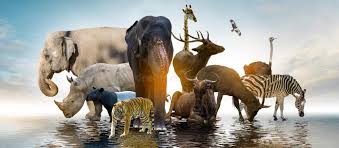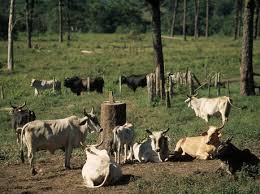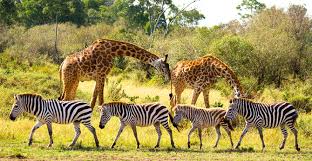Wildlife plays a crucial role in maintaining the balance of ecosystems and contributes significantly to human life and culture. It encompasses all living organisms that are not domesticated, including mammals, birds, reptiles, amphibians, fish, and invertebrates. Wildlife provides numerous ecological services, such as pollination, seed dispersal, and natural pest control, which are essential for the health of ecosystems.
Additionally, wildlife contributes to economic activities like tourism, recreation, and sustainable resource management, thereby enhancing local and national economies.
Effective wildlife management is essential to conserve biodiversity and ensure the sustainability of wildlife populations. This involves the scientific study and monitoring of wildlife populations and their habitats, as well as implementing strategies to mitigate threats such as habitat loss, poaching, and climate change.
Wildlife management aims to balance the needs of wildlife with those of humans, ensuring that natural resources are used sustainably while protecting ecosystems.
The concept of wildlife management is multifaceted and involves several key principles. One of the primary goals is to maintain healthy wildlife populations that can thrive in their natural habitats.
This requires understanding the ecological roles of different species and the interactions between them and their environment. For instance, predators play a vital role in controlling herbivore populations, which helps maintain plant diversity and overall ecosystem health.
Another critical aspect of wildlife management is habitat conservation. Protecting and restoring habitats is essential for supporting wildlife populations. This includes creating protected areas, such as national parks and wildlife reserves, where ecosystems can function without human interference.
Additionally, managing land use practices, such as agriculture and urban development, is vital to minimize habitat fragmentation and degradation, which pose significant threats to wildlife.
Community involvement is also an essential component of wildlife management. Local communities often rely on natural resources for their livelihoods, and engaging them in conservation efforts can lead to more effective management outcomes. Education and awareness campaigns can help foster a sense of stewardship for wildlife and their habitats, encouraging sustainable practices that benefit both people and nature.
The management of wildlife is further complicated by the need to address human-wildlife conflicts. As human populations expand and encroach on natural habitats, interactions between wildlife and humans become more frequent. These conflicts can result in economic losses for communities, particularly in agriculture, and pose risks to human safety.
Effective wildlife management strategies must address these conflicts through coexistence measures, such as using non-lethal deterrents and promoting sustainable land-use practices.
Wildlife and its management are critical for ecological balance, economic sustainability, and cultural heritage. Understanding the importance of wildlife and implementing effective management strategies can help ensure the survival of diverse species and the health of ecosystems.
As challenges such as climate change and habitat destruction continue to threaten wildlife populations, a proactive approach to wildlife management is essential for future generations. Through science-based practices, community engagement, and habitat conservation, we can work towards a sustainable coexistence with the wildlife that enriches our planet.
Understanding Wildlife Concepts

Wildlife refers to all living organisms that are not domesticated and exist in their natural habitats. This includes a wide variety of species, such as mammals, birds, reptiles, amphibians, fish, and insects. Understanding wildlife concepts involves recognizing the ecological roles these organisms play, their behaviors, and the ecosystems they inhabit. Key aspects include:
1. Biodiversity: Biodiversity refers to the variety of life forms in a given ecosystem. It is crucial for ecosystem stability and resilience, contributing to functions like pollination, pest control, and nutrient cycling.
2. Ecosystem Services: Wildlife contributes to essential ecosystem services, including clean air and water, soil fertility, and climate regulation. These services are vital for human survival and well-being.
3. Adaptation and Behavior: Understanding how wildlife adapts to their environments helps in conservation efforts. This includes studying feeding habits, reproduction, migration patterns, and social structures.
4. Threats to Wildlife: Wildlife faces numerous threats, including habitat loss, climate change, poaching, pollution, and invasive species. Understanding these threats is essential for effective conservation strategies.
Concept of Wildlife Management
Wildlife management is the practice of managing wildlife populations and their habitats to achieve specific conservation and sustainability goals. Key elements of wildlife management include:
1. Planning and Policy Development: Establishing guidelines, regulations, and policies that govern wildlife conservation and management practices.
2. Habitat Management: Protecting and managing natural habitats to ensure they can support healthy wildlife populations. This may involve habitat restoration, preservation, and sustainable land-use practices.
3. Population Management: Implementing strategies to maintain wildlife populations at sustainable levels. This may include monitoring populations, setting harvest limits, and conducting population surveys.
4. Stakeholder Engagement: Involving various stakeholders, including government agencies, local communities, and conservation organizations, in decision-making processes to ensure inclusive and effective management.
5. Legal Framework: Establishing laws and regulations that protect wildlife and their habitats, and ensure sustainable practices in hunting, fishing, and land use.
Read Also: How to Farm and Care for Daggertooth Pike Conger Fish (Muraenesox cinereus)
Importance of Wildlife Conservation

Wildlife conservation is vital for several reasons:
1. Preservation of Biodiversity: Conservation efforts help protect endangered species and maintain biodiversity, which is essential for ecosystem health and resilience.
2. Ecosystem Balance: Wildlife plays a critical role in maintaining the balance of ecosystems. The loss of a single species can disrupt food chains and lead to ecological imbalances.
3. Economic Benefits: Wildlife tourism, such as eco-tourism, can provide significant economic benefits to local communities. Healthy ecosystems support fisheries, agriculture, and other industries.
4. Cultural Significance: Many cultures hold deep connections to wildlife, viewing certain species as symbols of heritage and identity. Protecting wildlife helps preserve these cultural values.
5. Scientific Research: Wildlife serves as a subject for scientific study, providing insights into ecology, genetics, and conservation biology. Research on wildlife can inform practices that benefit both nature and humanity.
Types of Wildlife Management Strategies
Wildlife management strategies are designed to protect, conserve, and sustainably manage wildlife populations and their habitats. Key strategies include:
1. Habitat Conservation: Protecting and restoring habitats is crucial for the survival of wildlife. This can involve creating protected areas, wildlife corridors, and implementing land-use planning that considers wildlife needs.
2. Population Monitoring: Regularly monitoring wildlife populations helps assess their health and status. This information is essential for making informed management decisions and implementing conservation measures.
3. Sustainable Use Practices: Promoting sustainable practices, such as regulated hunting and fishing, allows for the utilization of wildlife resources without compromising their populations.
4. Community Engagement: Involving local communities in conservation efforts ensures that management strategies are culturally appropriate and beneficial. Community-based conservation initiatives can enhance local stewardship of wildlife.
5. Legislation and Policy: Implementing laws and policies that protect wildlife and their habitats is critical. This includes enforcing anti-poaching laws, protecting endangered species, and regulating land use.
6. Education and Outreach: Raising awareness about wildlife conservation helps foster a culture of respect for nature. Educational programs can inform the public about the importance of biodiversity and conservation efforts.
Habitat Conservation and Restoration
Habitat conservation involves protecting and managing natural environments to ensure the survival of wildlife and maintain biodiversity. It aims to preserve the habitats where animals and plants thrive, while habitat restoration focuses on rehabilitating degraded or damaged ecosystems to return them to a healthy state. Key points include:
1. Importance of Habitats: Natural habitats provide essential resources such as food, water, shelter, and breeding grounds for wildlife. Conserving these areas helps maintain species populations and ecological processes.
2. Conservation Techniques: Techniques for habitat conservation include establishing protected areas like national parks and wildlife reserves, creating wildlife corridors to connect fragmented habitats, and implementing sustainable land-use practices.
3. Restoration Efforts: Restoration may involve reforestation, wetland restoration, or removing invasive species. Successful restoration helps revitalize ecosystems, improve biodiversity, and enhance the resilience of habitats against climate change.
4. Monitoring and Research: Continuous monitoring of habitats and the species within them is crucial for assessing the effectiveness of conservation and restoration efforts. Research helps identify best practices and adapt strategies based on new findings.
Read Also: Apple Maggot: Description, Damages Caused, Control and Preventive Measures
Threats to Wildlife and Biodiversity

Wildlife and biodiversity face numerous threats that jeopardize ecosystems and the species that inhabit them. Some of the most significant threats include:
1. Habitat Loss: Urbanization, agriculture, logging, and infrastructure development lead to the destruction and fragmentation of natural habitats, significantly impacting wildlife populations.
2. Climate Change: Altered weather patterns, rising temperatures, and changing precipitation affect habitats and species survival, forcing wildlife to adapt or migrate.
3. Pollution: Contaminants from industrial, agricultural, and urban sources can harm wildlife directly or disrupt their habitats, leading to declines in populations and biodiversity.
4. Overexploitation: Unsustainable hunting, fishing, and harvesting of wildlife resources can lead to population declines and extinction of certain species.
5. Invasive Species: Non-native species can outcompete, prey upon, or bring diseases to native wildlife, disrupting local ecosystems and threatening indigenous species.
Role of Legislation in Wildlife Management
Legislation plays a crucial role in wildlife management and conservation efforts by establishing legal frameworks to protect wildlife and their habitats. Important aspects include:
1. Legal Protections: Laws such as the Endangered Species Act (ESA) in the United States protect threatened and endangered species from extinction by restricting activities that could harm them.
2. Regulation of Hunting and Fishing: Legislation can regulate hunting and fishing practices to ensure sustainable use of wildlife resources, including setting quotas, seasons, and methods to minimize overexploitation.
3. Establishment of Protected Areas: Governments can designate national parks, wildlife reserves, and marine protected areas through legislation, safeguarding critical habitats and species.
4. International Agreements: Treaties like the Convention on Biological Diversity (CBD) and the Convention on International Trade in Endangered Species of Wild Fauna and Flora (CITES) establish global commitments to conserve biodiversity and regulate international wildlife trade.
5. Enforcement: Effective legislation requires enforcement mechanisms to ensure compliance. This includes penalties for poaching, illegal trade, and habitat destruction, as well as resources for conservation agencies.
Community Involvement in Wildlife Conservation
Engaging local communities in wildlife conservation is essential for the success of conservation efforts. Key benefits and strategies include:
1. Local Knowledge: Community members often possess valuable knowledge about local ecosystems, species, and conservation practices that can enhance management strategies.
2. Empowerment: Involving communities in decision-making processes fosters a sense of ownership and responsibility for conservation, leading to more sustainable practices and stronger conservation outcomes.
3. Education and Awareness: Educational programs can raise awareness about the importance of wildlife and biodiversity, encouraging community members to participate in conservation initiatives actively.
4. Sustainable Livelihoods: Community-based conservation approaches can provide economic benefits, such as eco-tourism or sustainable harvesting of resources, which can reduce reliance on harmful practices.
5. Collaboration with Organizations: Partnering with conservation organizations, government agencies, and researchers can strengthen community efforts by providing resources, training, and technical support.
Economic Importance of Wildlife
Wildlife plays a significant role in the economy through various channels. Key points include:
1. Ecotourism: Wildlife attracts millions of tourists to national parks, wildlife reserves, and natural habitats. This tourism generates substantial income for local communities and governments, creating jobs and stimulating local economies.
2. Sustainable Resource Use: Wildlife provides resources such as meat, skins, and medicinal plants, which can be harvested sustainably. This supports livelihoods while ensuring that populations remain stable and ecosystems are preserved.
3. Biodiversity and Ecosystem Services: Healthy wildlife populations contribute to ecosystem services like pollination, seed dispersal, and pest control. These services are crucial for agriculture and forestry, promoting food security and economic stability.
4. Research and Education: Wildlife serves as a basis for scientific research and education. Studies on wildlife biology and behavior contribute to advancements in conservation, agriculture, and medicine, benefiting various sectors.
5. Cultural and Aesthetic Value: Wildlife holds cultural significance for many communities. The appreciation of natural landscapes and wildlife contributes to mental well-being and quality of life, fostering a connection between people and nature.
Principles of Wildlife Management
Wildlife management involves several core principles aimed at conserving and sustainably managing wildlife populations and their habitats. Key principles include:
1. Sustainability: Wildlife management should aim to maintain populations at levels that allow for natural reproduction and ecological balance while meeting human needs.
2. Adaptive Management: This principle involves using a flexible approach that allows management strategies to be adjusted based on monitoring and evaluation of outcomes. Continuous learning and adaptation are essential for effective management.
3. Ecological Integrity: Wildlife management should prioritize the health of ecosystems and biodiversity. This includes protecting habitats, restoring degraded areas, and maintaining ecological processes.
4. Stakeholder Involvement: Engaging local communities, stakeholders, and conservation organizations in decision-making processes ensures that management strategies are socially acceptable, effective, and beneficial to all parties.
5. Science-Based Practices: Wildlife management should be informed by scientific research and data. Understanding species behavior, population dynamics, and ecosystem interactions is crucial for making informed decisions.
Concept of Wildlife
Wildlife refers to all living organisms that are not domesticated and exist in natural environments. This includes a wide range of species, such as mammals, birds, reptiles, amphibians, fish, and invertebrates, as well as plants and ecosystems. Key aspects of the concept include:
1. Biodiversity: Wildlife represents a significant component of global biodiversity, contributing to ecological balance and resilience.
2. Natural Habitats: Wildlife thrives in various habitats, including forests, grasslands, wetlands, and oceans. These habitats provide essential resources for survival.
3. Wildlife as a Resource: Wildlife can be a source of food, medicine, and raw materials, but it also requires responsible management to ensure its sustainability.
4. Cultural Significance: Wildlife holds cultural, spiritual, and aesthetic values for many communities, influencing traditions and lifestyles.
Objectives of Wildlife Management
Wildlife management aims to achieve various objectives that support conservation and sustainable use. Key objectives include:
1. Conservation of Biodiversity: Protecting and restoring wildlife populations and their habitats to maintain biodiversity and ecosystem integrity.
2. Sustainable Resource Use: Ensuring that wildlife resources are harvested sustainably to meet human needs without compromising future generations’ ability to do the same.
3. Conflict Mitigation: Addressing human-wildlife conflicts through strategies that protect both wildlife and human interests, such as compensation programs or fencing.
4. Public Education and Awareness: Raising awareness about wildlife conservation issues and promoting responsible behaviors that support sustainable wildlife management.
5. Research and Monitoring: Conducting research to understand wildlife populations, behavior, and habitat needs, and monitoring these aspects to inform management decisions.
Do you have any questions, suggestions, or contributions? If so, please feel free to use the comment box below to share your thoughts. We also encourage you to kindly share this information with others who might benefit from it. Since we can’t reach everyone at once, we truly appreciate your help in spreading the word. Thank you so much for your support and for sharing!






